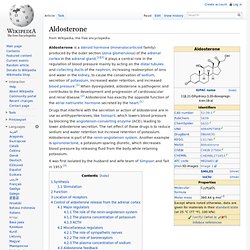

A Skeptic in Oz. Cross-posted from Science-Based Medicine I must say I was a bit shocked two weeks ago when I was contacted by a producer for The Dr.

Oz Show inviting me on to discuss alternative medicine. We have been quite critical of Dr. Mehmet Oz over his promotion of dubious medical treatments and practitioners, and I wondered if they were aware of the extent of our criticism (they were, it turns out). Despite the many cautions I received from friends and colleagues (along with support as well) – I am always willing to engage those with whom I disagree. How to Slow a Fast Heart Rate. In the photo, the carotid artery (red) runs up the neck between the Adam’s apple and the internal jugular vein (blue).

This is good to know when you need to do the carotid maneuver. (See the post.) by James Hubbard, MD, MPH You’re in the middle of a disaster or on a long hike, and suddenly you feel a little faint. Or maybe you feel butterflies in your chest. Improbable Research. Pain in Right Side of Chest. In most cases, chest pains instantly trigger fears of a heart attack, but they can also be symptomatic of other medical conditions.

Chest pains should never be ignored. Acne vulgaris, probiotics and the gut-brain-skin axis - back to the future? Acne vulgaris, probiotics and the gut-brain-skin axis - back to the future? Alexithymie - Emotional Inability. What Is Pili Multigemini? Research Studies on Fibromyalgia Skin Sensitivities. Does your skin burn or itch?

Do you frequently get rashes that just won’t go away? According to Charles Lapp, M.D., who treats hundreds of people with fibromyalgia at his center in Charlotte, NC, “fibromyalgia-related rashes occur in the majority of patients that I see.” Lapp, along with another experienced physician, Daniel Wallace, M.D., of UCLA, agrees that skin sensitivities are common in fibro. So what is it about your skin and its related tissues that make them so sensitive? Studies during the past 20 years may help explain why your skin is such a nagging issue. Corticosterone. Corticosterone (CORT) is a 21-carbon steroid hormone of the corticosteroid type produced in the cortex of the adrenal glands in rodents and other non-human animals.

Roles[edit] However, in humans, cortisol is the primary glucocorticoid that is produced primarily in the zona fasciculata of the adrenal cortex. It has only weak glucocorticoid and mineralocorticoid potencies in humans and is important mainly as an intermediate in the steroidogenic pathway from pregnenolone to aldosterone. Corticosterone. Zona fasciculata. The zona fasciculata constitutes the middle zone of the adrenal cortex, sitting directly beneath the zona glomerulosa.

Pregnenolone. Aldosterone. Aldosterone is a steroid hormone (mineralocorticoid family) produced by the outer section (zona glomerulosa) of the adrenal cortex in the adrenal gland.[1][2] It plays a central role in the regulation of blood pressure mainly by acting on the distal tubules and collecting ducts of the nephron, increasing reabsorption of ions and water in the kidney, to cause the conservation of sodium, secretion of potassium, increased water retention, and increased blood pressure.[1] When dysregulated, aldosterone is pathogenic and contributes to the development and progression of cardiovascular and renal disease.[2] Aldosterone has exactly the opposite function of the atrial natriuretic hormone secreted by the heart.[1]

Transcranial magnetic stimulation. Background[edit] Early attempts at stimulation of the brain using a magnetic field included those, in 1910, of Silvanus P.

Thompson in London.[2] The principle of inductive brain stimulation with eddy currents has been noted since the 20th century. The first successful TMS study was performed in 1985 by Anthony Barker and his colleagues at the Royal Hallamshire Hospital in Sheffield, England.[3] Its earliest application demonstrated conduction of nerve impulses from the motor cortex to the spinal cord, stimulating muscle contractions in the hand. Lipstick Mystic » Ayahuasca or Ayawaska. Ayahuasca or ayawaska, it’s still a dangerous herb that will force your third eye open with a crowbar, creating permanent damage to your psychic centers.

I know this isn’t a popular view. Especially if you’re one of those “cool-vegan-hikes-in-the-desert-loves-to-imagine-that-he’s-living-like-Carlos-Castaneda-and-he’ll-soon-encounter-Don-Juan” guys. You see, men are at a disadvantage when it comes to the psychic senses. They are more naturally centered in their lower chakras than women are. Women are more naturally centered in their upper chakras. By “lower chakras,” I don’t in any way mean “lesser.” Strong Lower Chakras Help You to Survive and Thrive Men have thicker, more intense energy in their lower chakras because for thousands of years they have needed to be out there killing mastadons and demonstrating incredible physical power to provide food for the tribe.
The Official Website for Acupressure Points. Charts for Acupuncture and Acupressure. Meridian Charts. Pseudofolliculitis barbae. Pseudofolliculitis barbae (/ˈsjuːdoʊfəˈlɪkjʊˈlaɪtɨs ˈbɑrbiː/; PFB), also known as barber's itch, folliculitis barbae traumatica, razor bumps, scarring pseudofolliculitis of the beard, and shave bumps, is a medical term for persistent irritation caused by shaving.[1][2] Pseudofolliculitis barbae was first described in 1956.[3] Etiology[edit] Pseudofolliculitis barbae (PFB) is most common on the male face, but it can also happen on other parts of the body where hair is shaved or plucked, especially areas where hair is curly and the skin is sensitive, such as genital shaving (more properly termed pseudofolliculitis pubis or PFP).

After a hair has been shaved, it begins to grow back. Curly hair tends to curl into the skin instead of straight out the follicle, leading to an inflammation reaction. PFB can make the skin look itchy and red, and in some cases, it can even look like pimples. This is especially problematic for some men who have naturally coarse or tightly curling thick hair. Rs6265. Rs6265, also called Val66Met or G196A, is a gene variation, a single nucleotide polymorphism (SNP) in the BDNF gene that codes for the so-called brain-derived neurotrophic factor. Well over a hundred research studies have examined the polymorphism.
Association with neuropsychiatric disorders[edit] In treatment response studies val/val homozygotes may respond better than met allele carriers with drug resistant depression treated with repetitive transcranial magnetic stimulation.[8] Subject variables in healthy humans[edit] Other studies[edit] A study in transgenic mice has found that met/met mice exhibits increased anxiety-related behaviors.[14] References[edit] 5-HTTLPR. Alleles[edit] One study published in 2000 found 14 allelic variants (14-A, 14-B, 14-C, 14-D, 15, 16-A, 16-B, 16-C, 16-D, 16-E, 16-F, 19, 20 and 22) in a group of around 200 Japanese and Caucasian people.[4] The difference between 16-A and 16-D is the rs25531 SNP. It is also the difference between 14-A and 14-D.[3] Some studies have found that long allele results in higher serotonin transporter mRNA transcription in human cell lines.
Fibro Fog and Dyscognition, Fibromyalgia Network. Otherwise known as “fibro fog,” dyscognition is the new medical term researchers are using to describe symptoms related to difficulty concentrating, disorganized thinking, memory problems, and inability to stay focused or alert. According to neuro-psychologist Jennifer Glass, Ph.D., at the University of Michigan, “These cognitive symptoms are often more troubling to the patient than other symptoms.”1 Reviewing the research findings for dyscognition in people with FM and CFS/ME, Glass states, “In the past, some controversy existed over whether the perceived cognitive problems could be demonstrated with objective testing.
However, enough evidence has now been found to safely say that objective cognitive deficits can be shown in both CFS and FM patients.” Heterotopic Epithelium in an Intramammary Lymph Node - Layfield - 2001 - The Breast Journal. What Are Menstrual Cramps? What Causes Menstrual Cramps? What Are Period Pains? , are painful sensations felt in the lower abdomen that can occur both before and during a woman's menstrual period. The pain ranges from dull and annoying to severe and extreme. Menstrual cramps tend to begin after an egg is released from the ovaries and travels down the fallopian tube (ovulation).
There are two primary types of these difficult or painful periods - primary and secondary dysmenorrhea: About half of women experience menstrual cramps, and about 15% describe the pain as severe. It has been shown that women who do not exercise experience more painful menstrual cramps. may also increase the likelihood of having uncomfortable menstrual cramps. Several underlying medical conditions are also capable of causing menstrual cramps. Most women are able to identify menstrual cramps without the help of a physician. NSAIDs are also used alone to reduce menstrual cramp pain. Sometimes, physicians will prescribe hormonal birth control pills. You may be able to prevent menstrual cramps.
Imipramine: MedlinePlus Drug Information. <span class="addthisnoscript">To use the sharing features on this page, please enable JavaScript. </span> pronounced as(im ip' ra meen)